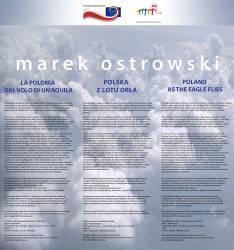
POLAND AS THE EAGLE FLIES
| An eagle soaring high in the air is a symbol of freedom, strength and majestic beauty. Such an eagle against a red background is the Republic's of Poland coat of arms. A view from the flight of an eagle soaring high in the sky over the territory, on which it at the same time is a historic symbol, seems of particular interest.
The exhibition "Poland as the Eagle Flies" shows space from a perspective that is inaccessible to most people, but extremely inspiring. Aerial photos - in the view of their author Dr. Marek Ostrowski - are not only a photographic technique but above all a way of thought. The higher we go, the broader the horizons of our thought. The same happens when we penetrate deeper into things we know.
Dr. Ostrowski is an academic teacher and researcher at the Faculty of Biology, Warsaw University, a member of the Committee on Space and Satellite Research of the Polish Academy of Sciences, who together with the Education Office of the Council of the Capital City of Poland provide patronage for this exhibition. He has been involved for tens of years in image information research and imaging in different ranges of electromagnetic radiation and in different scale, from the molecular level to satellite images. A considerable part of his research and creative activity is connected with aerial and satellite photography. His aerial photos are scientific documentation and a research tool but at the same time are striking in their aesthetics and composition. Of particular interest are novel and surprising interpretations of the contents of the photos which allow discovering new meanings and contexts. The photos and their interpretation are rich in information about both space and ….ourselves. Photos sometimes serve to build in real space entire exhibitions-towns, with scores of theme streets and parks. The photos can be read like literature, sometimes like poetry and at the same like a science publication that impacts our intellect both directly and, through emotions, indirectly.
Dr. Ostrowski is the author of several score large-format exhibitions, several aerial photography albums for which he has received awards, the creator of Warsaw Studies - Knowledge about the City and the educational project, the Warsaw Education Triptych, which creates a new model of school and education. More information: ProjektWarszawa.org, Warsaw Education Triptych.
The exhibition presents the natural and cultural landscapes and their interpretations of Poland - the country that presides in the 6-month term over the Council of the European Union. Poland is a country with unusually beautiful nature, with rich history and traditions, and which has repeatedly made its mark in European tradition.
The exhibition was organized by the organizing Committee of The Polish Term at the Joint Research Centre in Ispra on the occasion of the Polish Presidency in the Council of the European Union.
The exhibition will be accompanied by a lecture:
Part I - Introduction
Image information - a guide to space and the brain
Part II
Poland, Warsaw, Warsaw School.
The lectures will be held at the Circolo Velico di Cerro
Contact with author : samper@samper.pl, http://www.samper.pl |
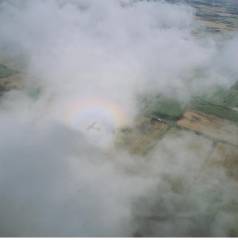
AN INVITATION TO VISIT POLAND
Gdańsk Bay - one of Poland's maritime windows on the world. In the distance Hel Peninsula.

HEL PENINSULA
Sandy spit created by currents in the Baltic Sea. This region is the northernmost part of Poland.
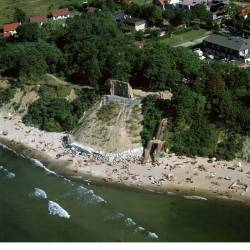
RUINS OF THE CHURCH IN TRZĘSACZ
Dynamics of the shoreline of a nation on the sea. Remnants of a church built in the 15th century, which at that time was 2 nation km away from the shore.
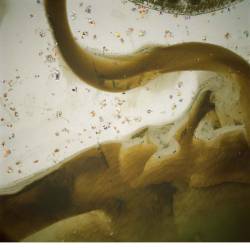
PIAŚNICA RIVER MOUTH
Beautiful sandy beaches are a traditional area for vacationing and contact with nature. The colour of the water stream entering the sea is caused by a suspension of humus compounds.

DUNES OF THE SŁOWIŃSKI NATIONAL PARK
Some of the largest dunes in Europe are shifted by winds along the Łeba Spit at 2-10 m a year. In the foreground the highest of them Łącka dune (45 m.a.s.l.), followed by the dunes: Gapa Mala and Pajęcza. The photo is a fragment of the first colour digital orthophotomap from 1994.
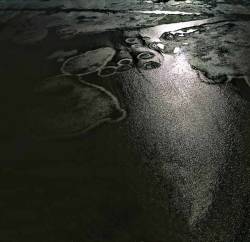
VANISHING MARINE BAY
Lake Drużno - a remnant of a large marine bay from thousands of years ago and the former Vistula delta. The Żuławy area is the site of the only local depressions in Poland.
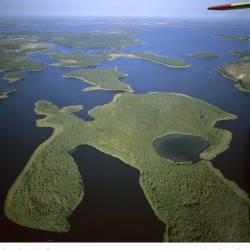
WARMIA, MAZURY
All of northern Poland is a picturesque region of post-glacial lakes, the largest of which is in its eastern part, Mazury. The photo shows medium-sized Lake Kisajno, with Dargin in the distance. The Masurian Lakeland is Poland's candidate in the international New7Wonders of Nature competition.
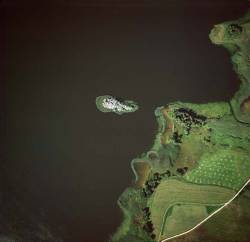
LAKE TUCHLIN, MAZURY
One of the Masurian lakes inhabited by wild cormorants.

WIGRY NATIONAL PARK
Imaging the uneven freezing of Lake Omólówek, in the region of the Polish cold pole, shows the dynamics of the turbulence of water streams inside the lake waters, which cannot be revealed using other techniques. The surface of the ice also shows tracks made by anglers.
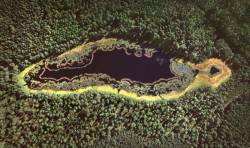
LAKE SMOLAK, MAZURY
An overgrowing lake in the final stage of succession. Though dying, it remains graceful. Knowing how to age gracefully is a great art.
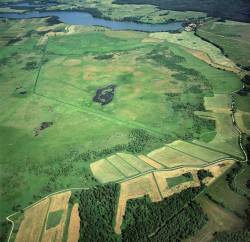
A LAKE WITH A PAST
A filled-up basin of an overgrowing lake is an early stage of moor formation. In the distance is the post-glacial lake Buwelno.
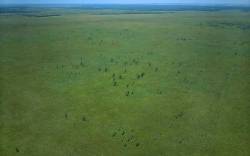
BAGNA BIEBRZAŃSKIE NATIONAL PARK
The one hundred kilometre long valley of the river Biebrza is one of the largest in Europe areas of swamps and peat lands as well as one of the largest in Europe preserve of natural wild nature. Impenetrable areas that are inaccessible to man are the kingdom of birds. Over a quarter of a thousand of bird species have been observed.
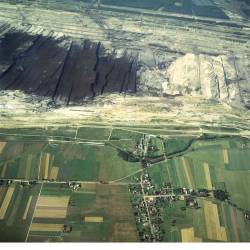
BELCHATÓW - COAL STRIP MINE
The richest and at the same time youngest bed of brown coal in Europe. A source of energy for man, but at the same time far-reaching degradation of the natural environment.
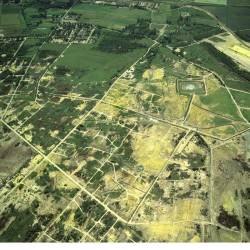
SULPHUR MINE IN GRZYBÓW
Sulphur beds formed as a result of natural microbiological processes, being the product of the degradation of sulphates (e.g. gypsum). The mining of sulphur is carried out by an underground melt-out method devised in Poland.
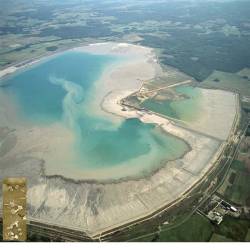
RETENTION RESERVOIR FOR POSTFLOTATION COPPER WASTES, LUBIN
Copper and many rare elements that accompany copper ores enable the development of many modern technologies. Post-flotation wastes are deposited in depressions of the terrain. On the side, a photo of bacteria leaching the wastes and recovering residual copper and silver, which are toxic to the environment (biotechnology patent).

RAVINE OF CENTRAL VISTULA
Millions of years ago the area of Poland was covered by warm ocean waters, in which life developed. Sedimentary limestone rock from the Cretaceous and Tertiary becoming uncovered on the slopes of the Vistula valley remain from this period. The several score metres thick layer of sediments, seen as the high shore of the valley, is built from the remnants of sea organisms. On the meadows on the bottom of the former ocean artists create works that can are visible from the escarpment.
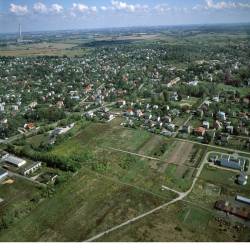
MAZOWSZE, WHERE THE FATE OF ANCIENT EUROPE WAS FORGED
Brwinów - a region of the great metallurgic centre form from the 1st and 2nd centuries AD with many thousands of single-use smelting furnaces found 50 cm under the surface of the whole small town. The photo shows a fragment with signs of melts from several score furnaces. The melted iron served to halt the expansion of the Roman Empire. West Mazowsze can be perceived as an economically leading settlement areas that directly influenced the political fate of Europe.
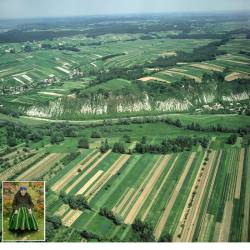
DOBRSKA ESCARPMENT
A steep tectonic edge separates Belżec Plain from Kotlina Chodelska. The agricultural landscape visible at the bottom of the photo is preserved in folk costumes in many regions of Central Poland. The natural landscape becomes a cultural landscape. On the side of the photo a 100-year old woman from Łowicz - Marianna Gać of the Tomala.
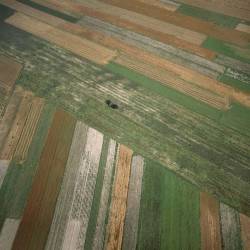
THE LOWLAND BELT OF CENTRAL POLAND
In the pattern of fields lakes and ponds, historical watch towers and strongholds can be perceived. Each fragment of space, like a human, has its own CV.
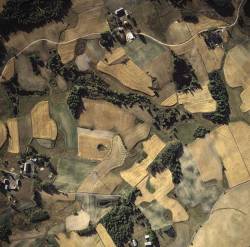
SZWAJCARIA KASZUBSKA
Charming landscape of individual small agricultural farms located on the slopes of small hills.

MOUTH OF BIEBRZA RIVER TO THE NAREW RIVER
The picture of natural meadows and traces of historical river networks and old-river basins. In such areas reign storks - a species that is particularly liked in Poland, like a close friend. It is associated with the national colours, freedom, nature.
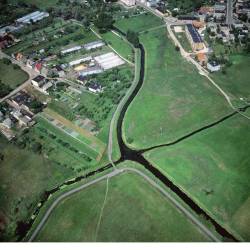
WELNA AND NIELBA RIVERS
The unique in the scale of the world crossing of two rivers near Wągrowiec (Wielkopolska) that flow through each other without their waters ever mixing.
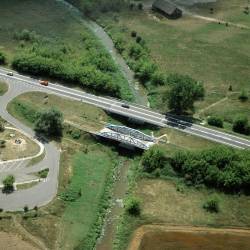
A BRIDGE OVER A RIVER AND SKYSCRAPERS
A small bridge - a historical town. It was created by a professor of the Warsaw University of Technology, Stefan Bryla. The bridge on the Sludwia River is the world's first iron bridge built using welding technology. The welded bridge, being much lighter than riveted structures, initiated the era of new steel skyscrapers, which it became the symbol of.
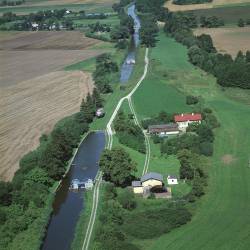
SHIPS MOVING OVER LAND
The Elbląg Canal built in the second half of the 19th century (designed by prof. eng. J. Steenke) is the only historical monument of this type of technological thought in Europe. The difference in elevation over a length of 10 km is 100 m. This problem was overcome by building a water canal combined... with inclined planes. The ships sail on water along the level sections and are transported up and down the slopes on special platforms.
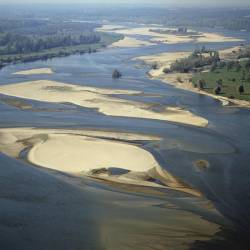
THE VISTULA - THE MOST BEAUTIFUL OF EUROPE'S RIVERS
The Vistula, called the queen of Polish rivers, is the last of the great rivers of Europe preserved in such a natural state. Its unique landscape includes steep banks covered by natural riverside vegetation, numerous islands and sand-bars create a value that is not encountered anywhere else in Europe. The valley of the Vistula is one of ogólnoeuropejskich ecological corridors.
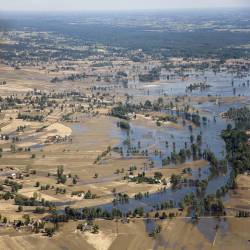
THE UNRULY VISTULA
Some fragments of the Vistula are confined by flood embankments built of soil, that protect against floods. During high water they do not, however, withstand the pressure of the water and then the area of former polders in the valley are submerged by a flood waters.
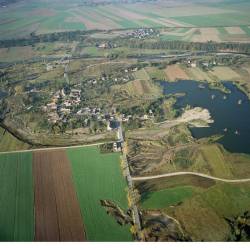
CASUS PILCE
Great floods impact the solid substratum to the extent that even whole villages can begin to move together with the soil. The photo shows an entire village that had just been rebuilt after a previous flood being abandoned for good .

ARCHITECTURE OF LAKES
Stawy Milickie (Lower Silesia). A fragment of a large group of 285 fish ponds located in the larger dales of the Barycza valley. Set up by the Cistercians in the 18th century Stawy Milickie, are the largest carp breeding centre in Europe, and at the same time one of the better known ornithological preserves in Europe.
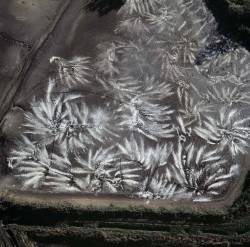
LIME SPREADERS
Fish ponds need to be sanitized every few years. The water is then drained. When the pond becomes small people enter the boggy area and manually, with characteristic motions, spread lime that disinfects the sediments and neutralizes their acidity.
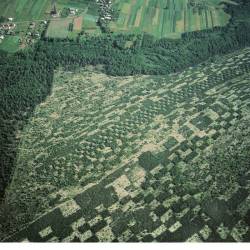
BLĘDOW DESERT
The remnants of an old dune from the glacial era. Until recently it was the only desert in Poland. On hot days even mirages are observed here. T present it has been afforested.

RAFTS
Forests are one of the many riches of Poland. Wood obtained from them was, whenever possible, transported along waterways. The logs floated down a river were tied into rafts. On the photo floating logs close to a mill.
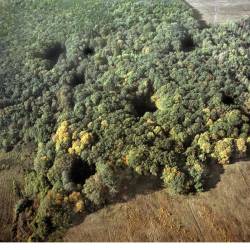
TRACES OF VISITORS FROM OUTER SPACE
There are only 16 places in the world where meteorites are known to have hit the Earth and only two of them are in Europe. One of them and the only one in Poland is the reserve in Morask close to Poznan. The depressions in the tree cover reflect mini-craters after the fall of a meteorite about 5 thousand years ago. At present they are filled with water. The largest crater has a diameter of 60 m and is 11 m deep.
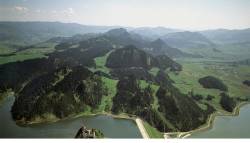
WESTERN PART OF PIENINY CLIPPEN BELT
Limestone cones tower over surrounding Carpathian Flysch. At the bottom of the photo the castle in Niedzica and water dam on the Dunajec River.
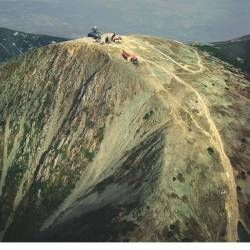
ŚNIEŻKA MOUNTAIN
Magiczna Góra (Magic Mountain) in the Karkonosze range is at the same time the highest peak of the Sudety Mountains (1602 m). The border between Poland and the Czech Republic runs through the peak. The characteristic shape of the rock cone is related to its geological structure (metamorphous rocks called hornfels).
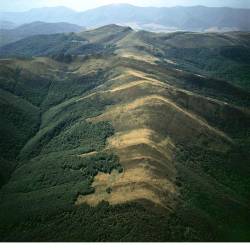
TARNICA, BIESZCZADY
Bieszczady - the mountains of dreamers, pioneers, settlers, adventurers, those searching for freedom, outlaws running from civilization. On the photo: alpine meadows in the Bieszczady Mountains, called poloniny.
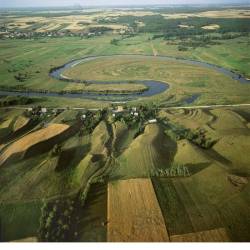
NAREW VALLEY NEAR LOMŻA
Richness of geomorphological forms of the river valley and of the activity of man. A large early stronghold from the Middle Ages surrounded by embankments and system of settlements outside the walls perfectly merges with the natural landscape.
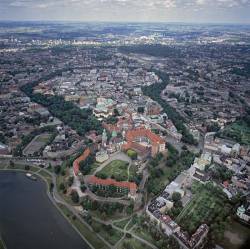
KRAKÓW - THE HISTORICAL CAPITAL OF POLAND
In the foreground Wawel - a hill composed of Jurassic limestone rock. At the peak is a castle from the 11th to the 18th century, where the kings of Poland were crowned and buried. The green wreath surrounding the Old Town, the old settlements outside the city walls, is a circular park - Planty.

CASTLES ON LIMESTONE INSELBERGS
A series of fortified castles was constructed in the 14th century during the reign of king Kazimierz Wielki, who "When he ascended Poland was wooden, when he left us, it was from stone", as a system protecting trade routes and the borders of Malopolska. It consisted of many castles and strongholds picturesquely located on tall rock formations (hence the name - Eagle Nests). On the photo Olsztyn - one of the castles along the Eagles Nests Trail, built of local limestone.

MALBORK - THE GRANDEST OF THE CASTLES OF THE KNIGHTS OF THE TEUTONIC ORDER
The three-part stronghold was built in 1278-1280 using close to 5 million bricks. From 1309 to 1457 it was the abode of the Grand Master of the Teutonic Order, the Ordo fratrum domus hospitalis Sanctae Mariae Theutonicorum in Jerusalem, and the town was the capital of the Teutonic state.
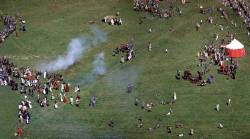
THE BATTLE UNDER GRUNWALD
One of the largest battles of medieval Europe took place on July 15, 1410 between the army of the Teutonic order, supported by western European knights, and the combined forces of Poland and Lithuania led by the king of Poland Wladyslaw II Jagiello. The war ended with the victory of the Polish-Lithuanian armies and a rout of the Teutonic forces. Every year on the anniversary of these centuries' events a reconstruction of the battle takes place.

SREBRNA GÓRA
Góry Sowie, the oldest mountain range, hides many secrets, not only geological ones. The stronghold Srebrna Góra was built by the king of Prussia Frederick II to protect the pass. Never conquered, it has become a monument of military technology.
During World War II the Germans began to drill kilometres of tunnels as well as gigantic factory halls in the hard rock of Góry Sowie. This was the implementation of the secret plan "Riese".
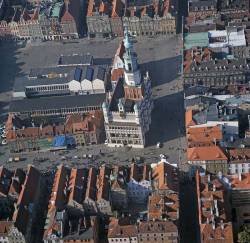
POZNAŃ - THE CAPITAL OF WIELKOPOLSKA
Site of the Poznań International Fair. On the photo - the renaissance town hall, on which at noon two mechanical billy-goats clash horns, accompanied by a bugle call. This is a tourist attraction and one of the many symbols of the town.
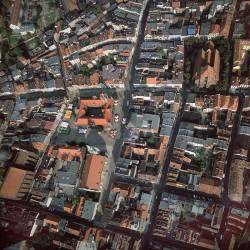
TORUŃ - THE TOWN OF COPERNICUS AND FAMOUS GINGER BREADS
Toruń - one of the oldest towns of Poland. The place where Nicolaus Copernicus - astronomer, mathematician, physician, economist and author of De revolutionibus orbium coelestium, was born (1473). The Toruń old town is on the UNESCO list of World Cultural Heritage.
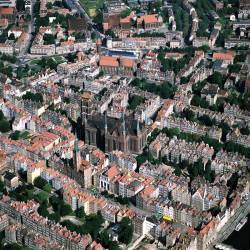
GDAŃSK - THE MARITIME CAPITAL OF POLAND
A port town, earlier a royal town. It belonged to the Hanseatic league of towns - a union of trade towns of Europe. The oldest part: The Main and Old Towns were 80 % destroyed towards the end of World War II. St. Mary's church seen in the centre of the photo is the largest Gothic brick church in Europe. Gdańsk is the site and symbol of the outbreak of World War II, the birth of Solidarity and the fall of communism in Central Europe.
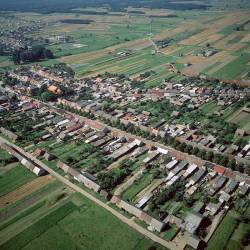
SULMIERZYCE
One of the traditional forms of agricultural farms in small rural settlements in central Poland.
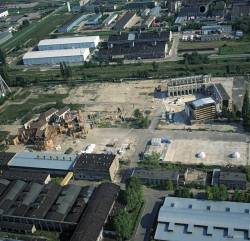
QUO VADIS
The senses serve to cognize the world. But the senses and consequently our mind can also be cheated to form non-existing worlds. A specific language creates film and theatre. Thanks to them, through fiction we enter reality.
The photo shows the set design for Jerzy Kawalerowicz's movie "Quo vadis" based on a book by the Polish Nobel prize winner Henryk Sienkiewicz. Between the 20th century industrial buildings ancient Rome from Nero's time was built. A temple, Vinicius's house, Chilon's abode, and even a bridge crossing the Tiber River can be seen. The set design burned down towards the end of filming.

FIRE
Today fires do not destroy whole towns like they did in medieval times but are still a tragedy for a specific family that loses the possessions of a lifetime or this year's crop.
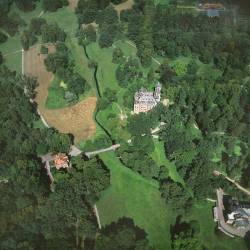
LIKE A CASTLE ON THE LOIRE
The architecture of the 16th century Castle in Goluchowo on the Ciemna river resembles the style of the castles along the Loire river. Its attractions are not only the castle and magnificent collections inside. The park is equally valuable. Over 1000 species of trees and shrubs grow on 160 hectares, forming a vast arboretum. The only forestry museum in Europe is here.
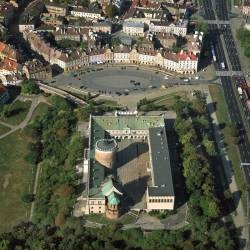
THE POLISH-LITHUANIAN UNION - A PRECURSOR OF THE EUROPEAN UNION
In July of 1569 in Lublin an international union of a specific nature was agreed to. As a result of the union decrees the Crown of the Polish Kingdom and the Grand Duchy of Lithuania was formed with a single foreign policy and a single ruler, who was elected at a joint session of the Sejm (Parliament). The Polish-Lithuanian Union became one of the first real European supranational unions. It was one of the longest functioning precursors of the contemporary European Union. The Union lasted until the partition of Poland towards the end of the 18th century.
On the photo the castle in Lublin - the site where the Union was signed and the original of the Lublin Union Act.
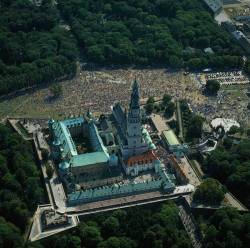
CZĘSTOCHOWA
The fortifications of the monastery-stronghold known as Fortalitium Marianum allowed it to withstand a 40 days long siege in 1655 40 day by the Swedish army during the large-scale invasion of Poland popularly known as the Swedish Flood. The spectacular defence of Jasna Góra encouraged the whole nation to take up arms and led to victory over the Swedes. From that time on the cult of the painting of Our Lady of Jasna Góra grew, and the Jasna Gora stronghold became not only a military stronghold and centre of religious cult, but a centre of patriotism and national traditions as well.
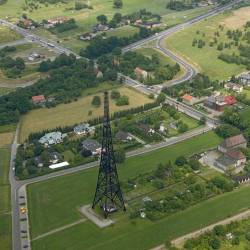
THE GLIWICE PROVOCATION
The 110 m tall Gliwice radio station built in the years 1935-35 110 m jest is the tallest wooden structure in the world. Before the War it belonged to the Third German Reich. The German provocation (a bloody attack on their own object by Germans dressed up and pretending to be Poles) at 8 pm on September was used as proof of an aggressive attack on the German nation, which could not remain without answer. Several hours later the German army entered Poland. World War II began.
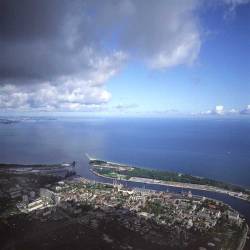
DARK CLOUDS MOVE OVER POLAND FROM THE WEST
Gdańsk - September 1, 1939, a salvo from the battleship Schleswig-Holstein that had come to Gdansk with a courtesy visit, fired from the sea visible in the photo towards the Westerplatte peninsula began World War Two. The defence of Westerplatte by Polish soldiers is one of the best known symbols of Polish resistance.
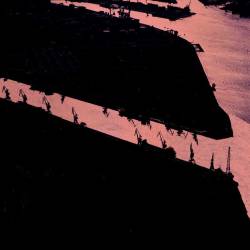
THE CRADLE OF SOLIDARITY
It was here, at Gdansk port, that on August 31, 1980, the August agreements between workers and the government, ending the nation-wide wave of strikes and protests, were signed. The events in Gdansk gave birth to a revolution that overthrew the communist system in Eastern Europe. An icon of Solidarity is Nobel Peace Prize winner and former electrician Lech Walęsa, who still lives in Gdansk.
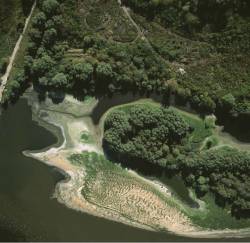
TOMATO ISLAND
The bird-shaped tomato island in the Vistula in the very centre of Warsaw, discovered and described by the photographer, is an example of anthropopression- the relation between the city and the Vistula. The light green ‘lawn' is composed of hundreds of thousands of tomato seedlings. Where did they come from? More on the unusual phenomenon of succession as seen in an aerial photo and the origin and story of the tomato island can be read in scientific papers and in the book The Face of Sawa.
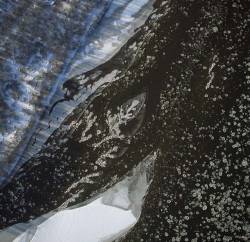
I GIOIELLI DELLA VISTOLA
La Vistola, come si addice alla regina dei fiumi dell'Europa del Nord, di tanto in tanto si decora con i gioielli di bellezza naturale. Nella fotografia i cristalli di ghiaccio della collezione della Vistola dedicati alle signore. La fotografia è stata fatta a Varsavia. Servirà come ispirazione a qualche gioielliere oppure grafico?
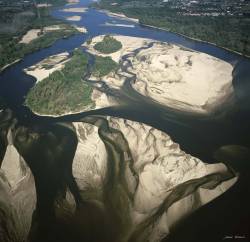
LA VISTOLA A VARSAVIA
Il carattere naturale dell'alveo della Vistola a canali intrecciati nell'immediata vicinanza di Varsavia e il continuo rinfrescarsi degli strati di sabbia e ghiaia vicini al fondo, trasportati dalla corrente, favoriscono i processi naturali di depurazione dell'acqua. Dell'acqua talmente pulita usufruisce la grande agglomerazione di Varsavia.
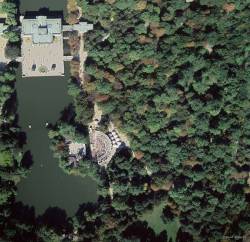
LAZIENKI GARDENS
The Lazienki Gardens is one of the largest parks in Europe. The summer residence of Stanislaw August Poniatowski was constructed in the 16th and17th centuries on the grounds of a former game park at the foot of Ujazdowski Castle that had been used for hunting by the dukes of Mazovia. On the photo - the Palace on the Water, the amphitheatre on the island, and, for the observant, a school of royal carp in the lake.

AN AFTERNOON ON THE GRASS
Present-day impressionism. Sunday on a hot afternoon. In the Saxon Gardens, of course. Separating the object from its surrounding alters the context and the image becomes a self-contained entity. This photo is a very big enlargement of the original. The figure on analog film is physically the size of a millimetre large dot.
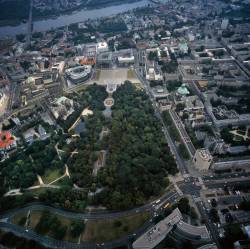
THE SAXON AXIS
The Saxon Axis, the largest Baroque urban complex in Warsaw, from the turn of the 17th and 18th centuries, is a kilometre and a half long, along which a series of buildings - and the extensive park called the Saxon Gardens - were designed. At the fringe of the park, along its axis, is the Tomb of the Unknown Soldier. On the photo - an autumn night in the Saxon Gardens.
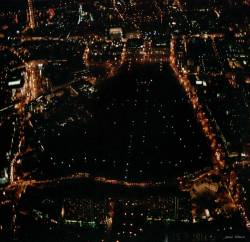
THE SAME PARK, THOUGH DIFFERENT
This is seemingly the same park as on the left and right sides. However, every change of viewpoint creates a new reality - this holds true for scientific discoveries as well. On the photo - an autumn night in the Saxon Gardens.
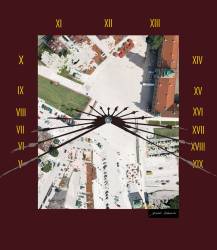
CLOCK SQUARE
A Column with the statue of king Vasa - one of the symbols of Warsaw, this time from a vantage point that is not accessible to tourists. The painting "The Sigismund clock" is the artistic processing of many shadows of the column registered in the course of 17 photogrammetric lights made in one day with precision of flight over the column within one metre.
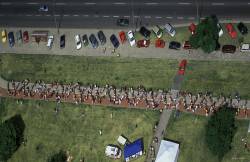
DNA
The motif of the Radio BIS Science Picnic in 2003 was simultaneously the 50th anniversary of the discovery of the DNA helix and the 100th anniversary of the first flight. Can both subjects, so different in notion and scale, from the molecular to the flight-related, be shown on one photo? A bit of creative fantasy and thus emerged an aerial photo of the DNA helix, spontaneously embracing all the participants of the picnic.
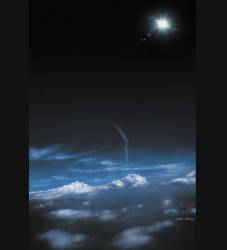
TWO SUNS
Exploring Outer Space expands horizons of knowledge, changes views on the genesis and form of life, and by providing a new reference point with regard to spacetime allows looking at the Earth differently. The photo shows the sky over Warsaw during the solar eclipse in August, 1999. It is worth considering where the image of the Sun is. The analysis of this image is one of the tasks in physics and geography to be solved at the Warsaw School and the Warsaw Education Triptych.

IMAGING OF AN IDEA
The image symbolizes the skill of selectively focusing on certain problems. Vehicle traffic isolated from the material context enables focusing on the idea and strategy of vehicle traffic as such, on what can be streamlined it in or what other innovatory solutions can be implemented? In further turn it can be related to material reality and figuring out where the intersection shown in the photo is.
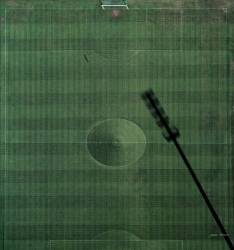
AVENUE OF INTERESTING PASSIONS
Passion - football. The photo shows the field of the Polonia stadium in Warsaw.
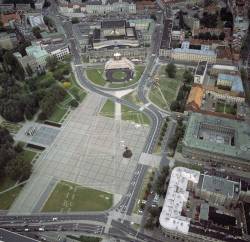
FAITH AND LIBERATION
In this place in 1979 John Paul II spoke words of great historical significance:
I call, I, a son of the Polish soil and I, John Paul II, pope, I call from the depths of this millennium, on the eve of the holiday of the Descent, I call together with all of you: [Lord,] let Your Spirit come down and renew the face of the earth. [And of] this land. These words spoken in Warsaw were one of the ignitors of the Solidarity revolution whose wave subsequently swept communism away from all of Central Europe.
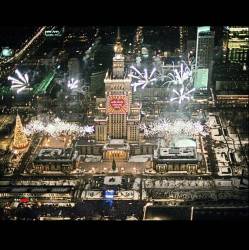
THE GREAT ORCHESTRA
The 14th Finale of the Great Orchestra of Christmas Charity of Jerzy Owsiak at Parade Square (Plac Defilad) in Warsaw ended with the happening of sending of a light into the sky. The idea of this charity enterprise with the participation of teenagers and children, its scale and continuity, are a phenomenon on the European scale.
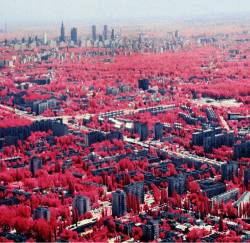
RED MEANS GREEN
Infrared radiation reflected by chlorophyll is registered on IR film as the colour red. The fitter the plants, the stronger they reflect infrared. The panorama in infrared shows Warsaw full of healthy vegetation.
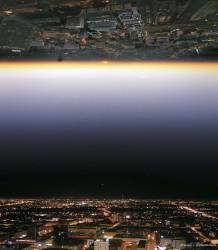
SPACETIME: TO THE EAST OF WEST
A panorama of not only space but also of time. The photo is the result of a two hour scanning of space from the moment of sunset (geographically West) to nightfall (towards the East).

PANORAMA OF WARSAW AT THE TURN OF THE CENTURIES
A miniature of the Panorama of Warsaw - at that time the largest circular panorama of a city in the world with novel form of imaging perspective.
It was unveiled on The Eve of the New Year beginning the 21st century and the third Millenium.
The panorama has also become a gateway allowing one to penetrate, in the broadest terms, into the space of the city - it has become the entry point for creating a modern Internet database of images about Warsaw.
http://panorama.varsovia.pl/widok/

ROYAL RESIDENCE BELONGING TO THE COMMONWEALTH
At the beginning of the 15th century, in place of a ducal stronghold of wood and earth, a mortar-work structure was built, which with time turned into a royal residence.
The Royal Castle in Warsaw was not the property of the king, but of the state. The king only had his headquarters there and this fact set the Warsaw castle aside from other royal castles in the world. This is also why the castle was called, correctly, ‘the Castle of His Royal Highness and of the Commonwealth.' The king had his official residence in the castle, but at the same time the Sejm of the Commonwealth met there, and the crown officials also worked in the building.
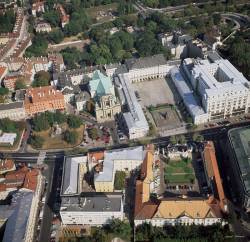
THE PRESIDENTIAL PALACE
The Presidential Palace is currently the seat of the president of the Republic of Poland. During the pre-uprising period (before 1831), the palace was the seat of the government of the Kingdom of Poland, then of the Warsaw Gubernatorial Government; in the years of the 2nd Republic and of the Polish People's Republic it was the seat of the Council of Ministers. The Warsaw Pact Treaty was signed in this building in 1955, and in 1989 it was here that the Round Table negotiations - the non-violent takeover of power - took place.
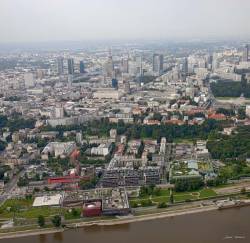
THE COPERNICUS SCIENCE CENTRE
In the foreground, just on the bank of the Vistula, is one of the most modern technologically and most interesting architectonically European science laboratories.
Here everyone, regardless of age, can experiment on their own and in a modern planetarium move in the space-time of micro- and macro-cosmos, in the depths of oceans or go back to the origins of life. This is another interesting reference point from which one can look at Warsaw and Poland.
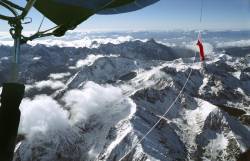
PANORAMA OF THE TATRA MOUNTAINS
Poland stretches from the Baltic to the Tatras. A look at the Tatras during a balloon trip and flight over the peaks of the Tatras - the highest mountain range in Poland, symbolically ends the journey through Poland that began over the Baltic.











































































